Surviving a major disaster is going to be perilous enough, and without the right skills and without taking the right actions, your survival is anything but guaranteed. Of course, surviving the onset of the disaster is one thing, but surviving in the aftermath is another.
Any disaster that qualifies as such is going to leave untold destruction and devastation in its wake, and the subsequent disruption of public utilities and the ever whirling gears of commerce is going to further complicate your life and your efforts to survive.
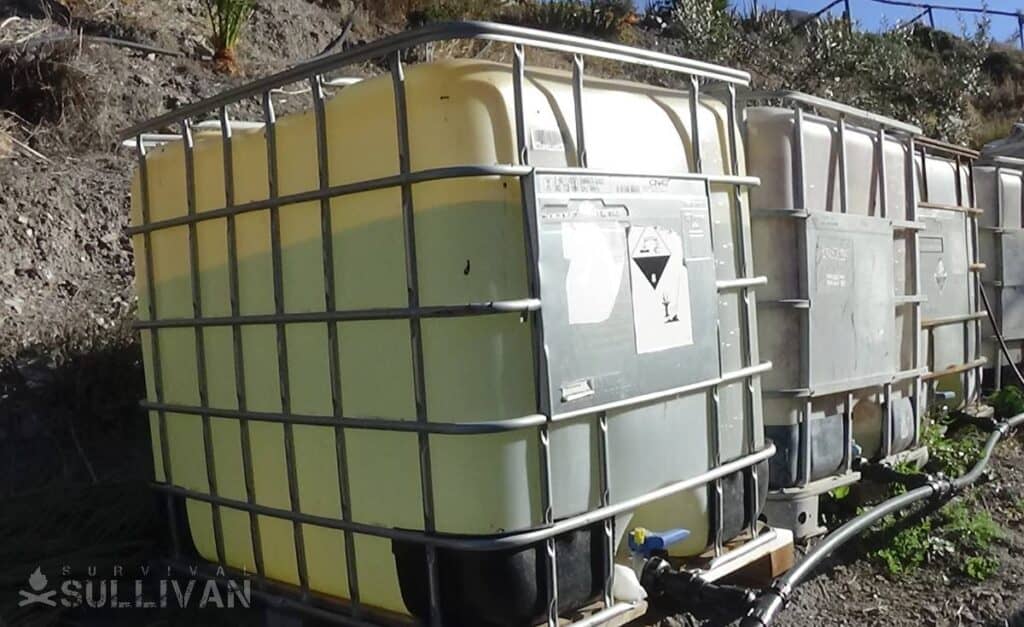
One of the most serious supply disruptions that preppers will face in the aftermath of a major disaster will be the loss or contamination of typical drinking water supplies.
Public water is likely to be shut off, or the pipes that carry it damaged badly enough that you cannot risk drinking it for fear of contamination. Even those of us fortunate enough to have a well on your property might not always be able to count on it depending on what has happened.
Stockpiling your own drinking water supply is, obviously, a good idea, but that supply will not last forever or the circumstances might be such that your supply is lost, destroyed or otherwise inaccessible.
Now, the pressure will be really on when it comes to hydration and you won’t have long to fool around.
To help you be better prepared to keep the H2O flowing in the aftermath of a disaster we have prepared a list of 15 emergency water sources that you’ll be able to depend on after a disaster.
Table of Contents
Don’t Take Found Water Quality for Granted
When considering any source of emergency water, you must not take the quality of that water for granted just because you found it on this, or any, list.
Avoiding or eliminating contamination is the name of the game, and no source of water is the same as the next and sometimes appearances can be deceiving.
If you choose poorly, or fail to account for biological or chemical contamination you or someone you love might become seriously sick, or even die.
This is especially important to keep in mind when you are thinking of drawing water from a natural source such as a stream, pond, lake or river.
Popular conception has some people and even more than a few preppers believing that natural water sources, particularly remote ones away from human habitation, are somehow innately clean and safe to drink from.
This is patently false, as these bodies of water are full of all sorts of biological matter and attendant microorganisms.
Even otherwise inaccessible and nominally clean sources of drinking water produced by human industry could be dodgy. Chemicals can leach out of pipes, rust and buildup can taint water trapped in reservoirs, and so on and so forth.
This does not even factor in the likelihood of accidental (or deliberate!) contamination, chemical or biological, from any number of sources.
The bottom line is that you must be prepared to filter or otherwise purify your water no matter where you get it from, as there are very, very few “safe bet” options, and those are likely to be in vanishingly short supply in the aftermath of a disaster.
If you are unable or otherwise unwilling to continually filter what water you are able to gather, you’ll have to roll the dice on the cleanest-looking water source that you can find.
15 Emergency Water Sources during Any Disaster
1) Rainwater
Rainwater is among the very best emergency water sources that you can draw from in a post disaster situation. The only problem is actually getting it to rain, as there is nothing you can do about that!
That being said, even a passing shower can produce a tremendous amount of water if you are prepared to harvest it in quantity.
When it comes to collecting rainwater, there are various purpose made and improvised solutions that you can call upon.
You can place buckets, tubs and other containers out to catch the rain directly, or even better, place than beneath natural funnels that will direct a mass of water into them.
A clever prepper will have already equipped their house with rain barrels and a diverter system on their downspout.
You can even take tarps and other large sheets of impermeable plastic that will direct the rain water into a larger cistern. If push comes to shove, you can even collect rainwater right out of puddles or other found sources on the ground.
There are a few things to keep in mind about rainwater though…
First, in some places it might be anything but dependable depending on the regional climate and typical weather. A good, hard rain when you need it if you live in the American Southwest might as well be a bona fide miracle.
If you live in the Pacific Northwest or the American South, in the spring and summer it will be more or less dependable over time.
But no matter how you slice it, rainwater is one of the very, very best sources of nearly pure drinking water you can get, so make sure you’re prepared to capitalize on it!
2) Dew
The early morning or late evening due that forms on grass, plants and even glass might seem like an annoyance or the fodder of sappy poetry considering how little water is actually there, but for the diligent or desperate prepper this water can be collected and repurposed for drinking.
The trick is actually harvesting it. You can use a clean sponge, a rag, or some other cloth to wick up the water before depositing it in a container.
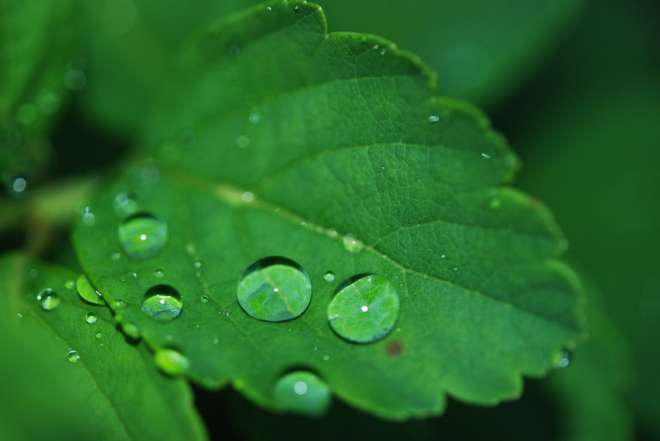
Note that you’ll have to swipe many leaves and other surfaces to get enough water to even make a generous glass, but if you work quickly it can be done. You’ll be racing the clock against evaporation, so don’t waste any time, and also take care that you aren’t getting the water off any potentially hazardous plant or other surface.
If you have a large, smooth surface that dew can be collected from, you can use a clean squeegee to rapidly draw off all of the droplets at once. Make sure you are set up ahead of time with some apparatus to catch and direct this water or it will go to waste.
For preppers with many mouths to feed collecting dew will likely be an activity of last resort, but if you are in a major bind and need water right away, or just enough to keep you going, it is a workable option.
3) Melt Ice
Ice is another great source for getting some quality drinking water depending on what water source originally constituted in the ice. Ice is a naturally occurring and man-made, and available from a variety of sources depending on your context and where you live.
If you live in a cold region or are in a temperate region in the middle of winter, you can likely access ice year round in the form of icicles or snow. In many such regions both will be more or less ever present and you’ll be able to harvest your fill for subsequent melting into water.
Anywhere you find people, electricity and modern civilization though you will be able to find ice in the form of ice cubes.
The frost inside your own freezer, ice from the ice machine, bagged ice from groceries and convenience stores and other places besides ice is a fixture luxury in modern America.
Work quickly, though, because no matter how insulated the container this ice will not last after the loss of power sees refrigeration cut off.
As always, make sure you take care to filter or purify the water you gain as appropriate depending on the source of the ice: A nasty icicle dangling off the edge of a building in an urban area might warrant some extra care, as would ice harvested out of a frozen puddle.
Bagged ice or ice out of your freezer need only be thawed before it may be safely drink so long as the ice was made prior to the onset of the event that compromised the water supplying the machine.
4) Ponds
A conveniently located pond is likely to be the very first source of water that suburban and rural preppers alike turn to after our everyday sources go kaput in the aftermath of a disaster.
There are definitely convenient, and can be a valuable source of emergency water, but most ponds are positively filthy, swimming with hordes of microbiological life with some of it being harmful or even potentially fatal to humans if ingested. I do not exaggerate when I say that ponds are literally ecosystems unto themselves.
Any water that you draw from a pond must be filtered before you drink it if you don’t want to risk getting sick, at best.
Considering how dirty most pond water is, you would be well advised to pre-filter the water using various simple methods prior to running it through your dedicated emergency water filter or adding your sterilization chemicals. This will ensure prolonged filter life or maximum efficacy from your additives, respectively.
Also, make sure that a pond you are drawing from is not located near the runoff area of a farm or any other industrial area as it might be dangerously contaminated with chemicals or other substances that typical filtration and purification methods will not reduce! If in doubt, look elsewhere!
5) Lakes
For our purposes, a lake is basically a supersized pond. They are immense sources of emergency water that are unlikely to run out or otherwise disappear save the most calamitous events or prolonged droughts.
However, just like ponds there are full of all sorts of life, large and small, and host to every kind of gribbly microorganism they can potentially make you very sick.
But unlike ponds, there is a chance of improving the overall quality of the water you harvest from a lake if you have any way to get away from the shore and draw it from the center, or at least further out.
Though this will do nothing to eliminate the requirement of filtration or other purification methods, it will cut down on the larger solids and dissolved matter that will be in your harvested water.
So long as you have reliable filtration and purification methods close at hand, consider the presence of a large freshwater lake near your home a boon for post disaster living.
6) Rivers and Streams
Rivers and streams both serve as an alternative option for naturally sourced water alongside ponds and lakes.
Compared to the latter two most folks would instinctively get their water from a moving source if possible, with the common sense notion that moving water is somehow cleaner or safer than still, standing water.
There is a grain of truth to this, as stagnant water is often nasty or overall the moving water, but water from a river or stream still requires treatment before it is a sure safe bet to drink.
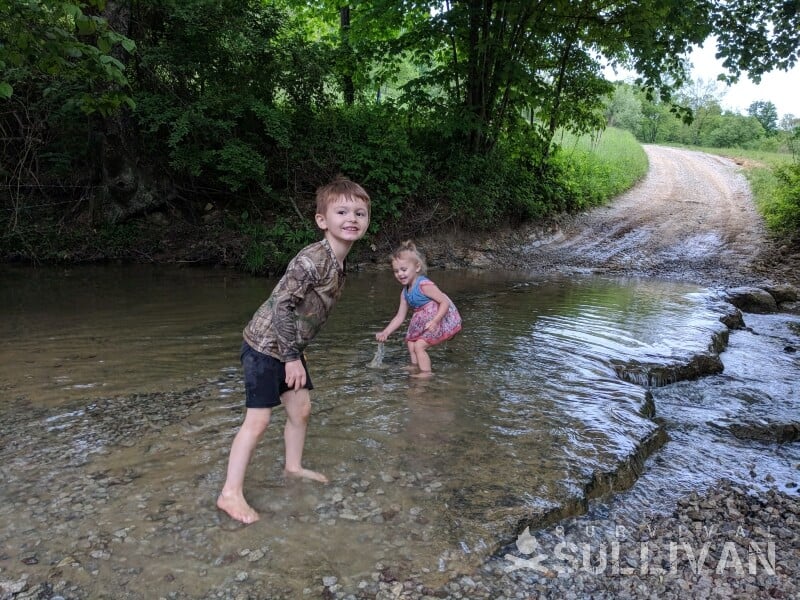
Also, one must consider that the water you get from a river or stream could have traveled quite a long distance before it got to you.
Between you and the water that you just drew, it could have passed over multiple animal (or human) carcasses, countless sources of contamination both man-made and natural, trash, garbage, heavy metal deposits and more.
So while the water looks clean, clear and refreshing as it burbles along, remind yourself that it is likely as dirty as any other.
Even so, rivers and streams are both excellent sources for clever preppers to make use of so long as some care is taken in purifying after it is drawn.
7) Transpiration
You probably already know that you lose a certain amount of moisture, more than you might think actually, just from breathing constantly every day; the process of respiration results in moisture loss.
But did you know that plants go through a similar process as part of their basic biology, a process called transpiration. Even better, it is possible to capitalize on this process and harvest clean, fresh water from them.
The operation is simple, if tedious. All that you need to do is locate green, leafy plants in an area that receives plenty of direct sunlight, and the more leaves and the broader they are the better.
Then, drape a thin, waterproof plastic sheet over the plant before gathering it at the bottom and directing it into a small container. Dew-like drops will form on the inside of the plastic, and trickle to the bottom before collecting in your container.
You probably already guessed, correctly, that this process will not yield much fresh water, but performed on multiple plants as part of a widespread “farm” operation it can definitely be worthwhile, especially in areas where larger natural sources are scarce or non-existent.
Always double check to ensure that the plant you are harvesting water from is not toxic, irritating or in any other way dangerous or you will regret it!
8) Home Water Pipes
In the event that the water supply running to your home is suddenly interrupted, there will still be a quantity of water trapped in the pipes, only it will lack the pressure to reach the taps.
With a little bit of knowhow, you can extract this water which might be enough to keep you underway while you look for more sizable and certain sources.
To access this water, in any multi-level building (including a typical two-story residential home) what you first need to do is open every tap and outlet that you can on the highest level of the structure.
Next, grab your container or whatever you’ll be using to harvest the water and go to the taps on the lowest level of the building. Now open those taps and collect your water. By opening the uppermost faucets you allow gas into the pipe system, freeing the stuck, clean water within.
If you live in a suburban or urban area with many multi-level buildings this is a great way to harvest a significant quantity of known quality drinking water early on before it evaporates because most folks do not know about this trick.
9) Water Heater
Your home water heater contains many gallons of water, and can serve as an easily accessible reservoir that you won’t even have to go out and hunt for after normal water supplies are interrupted or exhausted.
The trick is preventing the water heater from becoming contaminated in the event that public supplies or your personal well are compromised.
Loss of water supply is one thing, as your water heater will keep its internal supply, but should the water supply become contaminated that water will make its way into your water heater in short order.
It is for this reason that you might want to consider shutting off the water inlet supplying the water heater as soon as you know that a situation is developing.
To harvest the water inside your water heater, simply ensure that the heating element is shut down and the water heater itself, along with the water inside, is cool.
Now, either attach a hose to direct the water or get a big container and open the tap near the bottom of the tank after opening the relief valve near the top.
Make sure you have your ducks in a row before performing this operation as any mishaps or broken tap handles could see that water flooding your home, not to mention going to waste!
10) Garden Hose
In warmer areas or seasons, you can reliably find clean water trapped inside garden hoses that have been shut off but remain connected to their spigots.
To get to it, all you’ll need to do is carefully disconnect the hose, place one end in your container and then systematically raise, hand over hand, the far end.
This will sort of “herd” the water through the hose and into the container. Not every hose will hold water in this way, but most will, especially when they are left connected.
Though all it might take is a few visits to houses in your area to procure this water, and the water inside is nominally fresh, I should tell you that many hoses will (supposedly) leach trace amounts of chemicals into the water they contain, hence the common admonishment that “you should never drink from the garden hose!” we see everywhere today.
Trust me; in the middle of a major disaster you’ll have bigger problems. Make sure you hit this source quickly if it is an option for you because that water is liable to trickle out or evaporate over time.
11) Toilet Tank
The tank on the back of your toilet contains a clean and nominally drinkable source of fresh water. Note that I said the tank, not the bowl, and you should never drink water from a toilet bowl under any circumstances unless you have absolutely no other choice and purify the hell out of it.
However, even drawing water from the toilet tank there are a few things you should be aware of. First, any liquid or solid bleach, cleaners, fresheners and other such trickery will render the water unusable.
Second, there can still be significant sediment contamination from rust, particulates from rubber and plastic tank hardware and other sources. As always, if possible you should filter this water before drinking it.
So long as your toilet tank is free of any major rust deposits and the aforementioned additives this is another easy to access and ready source of water you can draw from in an emergency.
12) Vending Machines
If there is one thing you’ll be able to count on during any major crisis it is that all typical stores, shops and grocers will run out of product in no time flat.
Bought ahead of time by worried shoppers, scarfed up in the aftermath by opportunistic looters or appropriated by desperate survivors, the shelves will empty with shocking speed and they will not be restocked. This means that bottled water that everyone covets so will vanish seemingly overnight.
However, there is still a good chance of scoring pure, clear drinking water from a vending machine.
It won’t take long for people to remember to check these machines for bottled water and other beverages, but if you act fast and look in an out of the way place for a rarely used machine you are likely to find a few bottles.
If the power is on, insert your change and receive your drink. If the power is off, you’ll have to get creative and a little vandalous, so don’t do this unless you have a serious need. These machines can easily be broken into with most heavy duty crying or demolition tools.
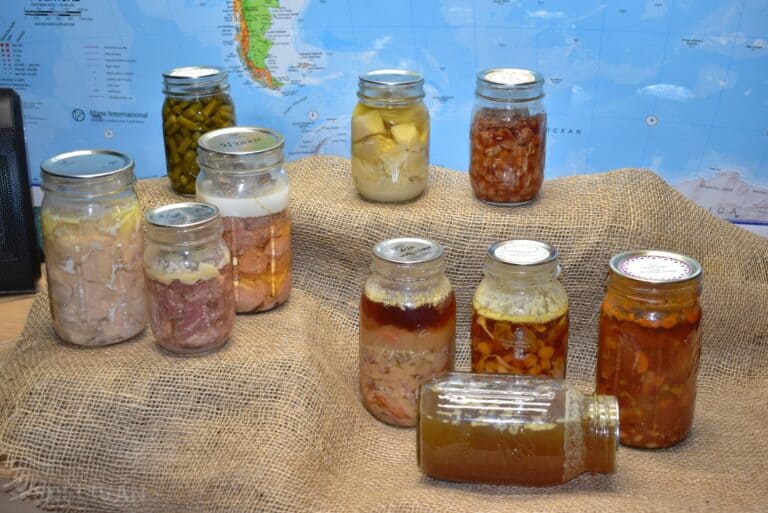
13) Canned Goods
Now, don’t bawl me out in the comments over this one. Some fruits are packed in light or heavy syrup, or fruit juice, and not water, but most vegetables are packed in water, not oil, and both canned fruits and veggies can make excellent, impromptu sources of hydration when you are in a bind.
Even the water that most tuna comes packed in can rehydrate you.
I get it, the notion of guzzling anything except sweet, pleasant fruit juice out of a can is enough to make you feel slightly queasy, and I’m not arguing, as lima bean water is not my idea of thirst quenching refreshment, but no matter what you are drinking it will definitely beat dying of dehydration.
One thing to keep in mind when relying on any canned food related liquid is that sugar and salt levels might be problematic if you are already very dehydrated.
If you are running low on water or already out, this is a good source of liquid to lead with before you go looking for more.
14) Pools and Fountains
In residential and urban areas pools, fountains and other large decorative or functional bodies of water can be one of the most easily accessed and plentiful sources of water you are likely to find, and with a little luck one of the cleanest.
An average residential swimming pool will hold hundreds of gallons of water, and a half or full size Olympic pool will hold thousands. Assuming you don’t have thousands of people drawing from it, this water supply will last for a long time.
Now, the condition of the water bears consideration. A pool that is regularly used, regularly maintained, and otherwise in good shape is going to be extremely clean, even if it is lightly contaminated with typical pool cleaning chemicals.
This water may even be ready to drink, though it should be done sparingly until it is given plenty of time to “off gas”: many pool chemicals, including chlorine, break down over time and are rendered harmless.
An old, neglected and nasty pool is little better than a pond, and care should also be taken with public fountains because they are not maintained, as a rule, to the same typically high standard of cleanliness a commercial or residential swimming pool is.
No matter which one you draw from, both will benefit from filtration and purification by the normal methods. Even so, having access to a pool, hot tub or fountain pretty much by yourself is cause for rejoicing!
15) Solar Still
A solar still is an ingenious device that can harvest condensation in the form of moisture released from the ground.
The best part about the solar still is that it can easily be set up using only rudimentary materials and can function almost anywhere you have a small, flat patch of ground.
The shortcoming of the solar still is that the amount of water collected is, similar to the plant transpiration method discussed above, very small and should be “farmed” with multiple installations for best results over time.
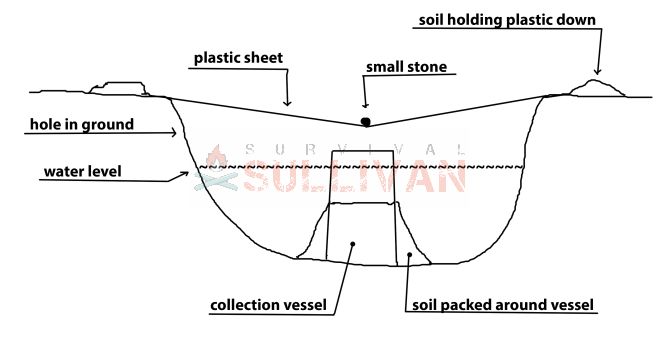
To set up the solar still, all you need to do is dig a shallow pit in the ground in any location that receives copious, direct sunlight and then place over it a sheet of plastic.
This sheet of plastic should be secured using dirt or rocks to seal it flush with the ground and prevent the evaporating moisture from escaping.
Before you seal the last side down, place a small container in the center of your pit and then place a small weight, pebble or whatever on top of your plastic to form a depression directly over the container.
Then all you’ll need to do is seal the final side as above. With time and direct sunlight, moisture escaping the ground will condense on the underside of the plastic before inexorably trickling to the center depression and then dripping into your container where you can later collect.
Yes, the method is agonizingly slow but the good news is the water you do collect will be extremely pure and ready for drinking.
Conclusion
No matter what the situation and no matter how prepared you are you must not ever run out of drinking water.
Second only to exposure, dehydration can kill you quicker than almost any other typical survival hazard, with most people expiring from a complete lack of water in just a couple of days.
No matter how much water you have stockpiled you must always be prepared to source some more, and it pays to know a variety of sources, natural and man-made, where you can get your next drink.
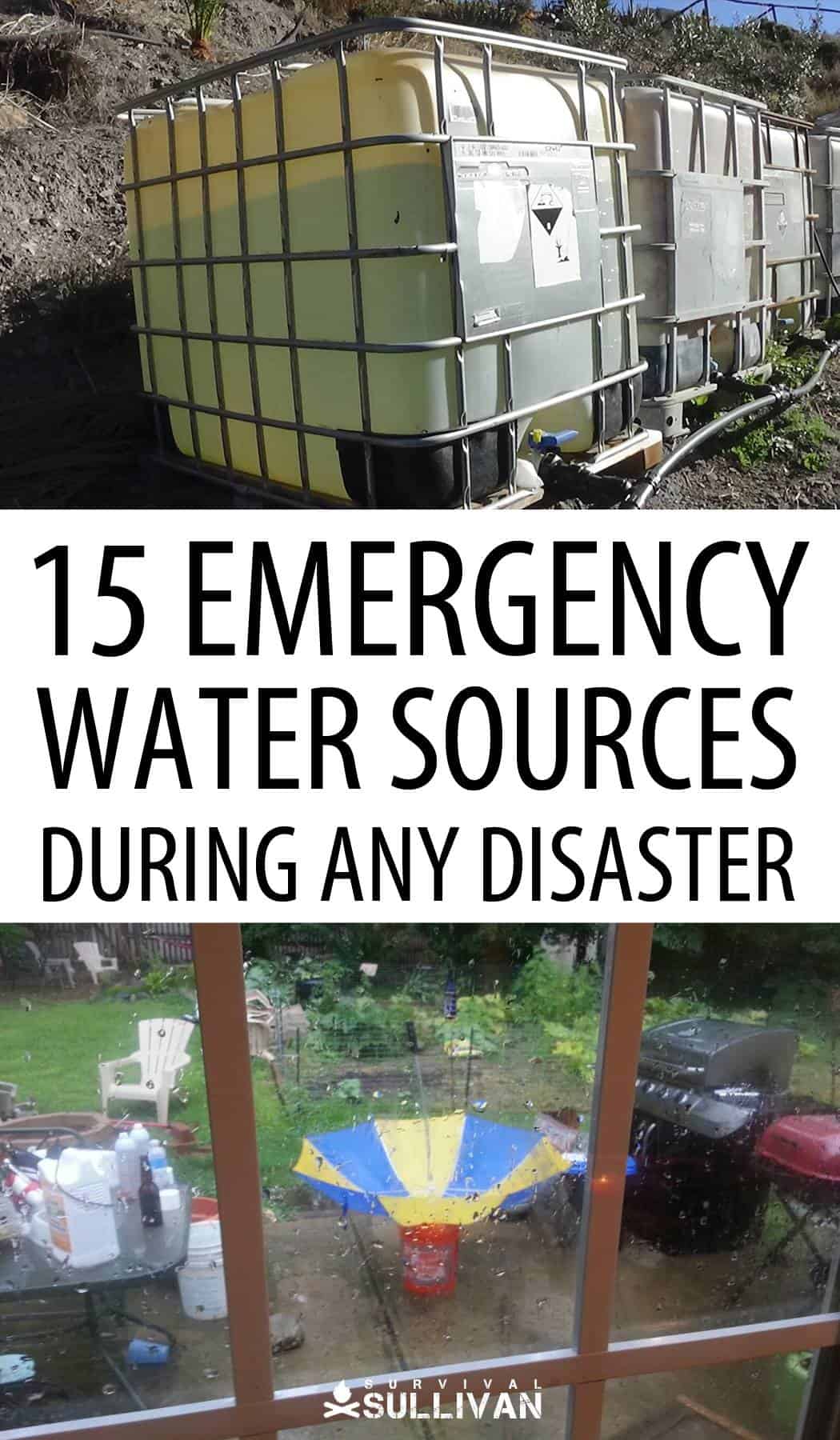

Tom Marlowe practically grew up with a gun in his hand, and has held all kinds of jobs in the gun industry: range safety, sales, instruction and consulting, Tom has the experience to help civilian shooters figure out what will work best for them.

Why not try to dig a well in your backyard, in the old days everyone had a well on their property. It can be kept covered to help keep debris out of it. A metal bucket would be much easier to keep clean than a wooden one.